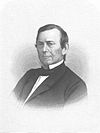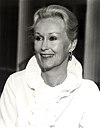Ohio's 19th congressional district was created following the 1830 census and was eliminated after the 2000 census. Between 1863 and 1880, it was represented by future US President James A. Garfield, who became the only sitting House member ever to be elected to the Presidency.

Thomas Charles Sawyer was an American politician of the Democratic Party. During a career that spanned five decades, he represented his hometown of Akron, Ohio, across multiple levels of government. He was a member of the Ohio House of Representatives from 1977 to 1983, the Mayor of Akron from 1984 to 1986, a member of the United States House of Representatives from 1987 to 2003, and a member of the Ohio Senate from 2007 to 2016.
The 20th congressional district of Ohio was created after the 1840 census. It was eliminated in the redistricting following the 1990 census, and redistricted and renumbered as the 10th district.
The 21st congressional district of Ohio was a congressional district in the state of Ohio. It was eliminated in the redistricting following the 1990 census.
The 22nd congressional district of Ohio was eliminated as a result of the redistricting cycle after the 1980 census.
The 23rd congressional district of Ohio was eliminated as a result of the redistricting cycle after the 1980 census. The district had been created after the elimination of Ohio's at-large congressional district after the 1950 election.
The 24th congressional district of Ohio was created for the 1966 election, after the banning of at-large seats by the Voting Rights Act of 1965. It replaced Ohio's at-large congressional district. It was eliminated in the redistricting following the 1970 census. At the time of its creation, it consisted of the southwestern counties of Preble, Butler, Warren and parts of southern and eastern Montgomery.
Ohio's at-large congressional district existed from 1803 to 1813, from 1913 to 1915, from 1933 to 1953 and from 1963 until 1967, when it was banned by the Voting Rights Act of 1965.

Texas's 17th congressional district of the United States House of Representatives includes a strip of Central Texas and Deep East Texas stretching from Nacogdoches to Waco and Round Rock, including former President George W. Bush's McLennan County ranch. The district is currently represented by Republican Pete Sessions.

New York’s 28th congressional district is an obsolete congressional district for the United States House of Representatives. Before becoming obsolete in 2013, the district was based in Rochester, Buffalo, and Niagara Falls, and included parts of Erie, Monroe, Niagara and Orleans Counties. Its easternmost point was in Fairport at the home of its final representative, Democrat Louise Slaughter. Due to its gerrymandered shape it was sometimes known as "the earmuffs."

West Virginia's 2nd congressional district consists of the northern half of the state. It contains Barbour, Berkeley, Brooke, Doddridge, Grant, Hampshire, Hancock, Hardy, Harrison, Jefferson, Lewis, Marion, Marshall, Mineral, Monongalia, Morgan, Ohio, Pleasants, Preston, Randolph, Ritchie, Taylor, Tucker, Tyler, Upshur, Wetzel, and Wood counties.
Ohio's 11th congressional district encompasses portions of Cuyahoga County in the Northeast part of the state—including all of Cleveland. It has been represented by Democrat Shontel Brown since 2021.
Ohio's 5th congressional district is in northwestern and north central Ohio and borders Indiana. The district is currently represented by Republican Bob Latta.
Ohio's 6th congressional district is a U.S. congressional district which is represented by Representative Michael Rulli of the Republican Party. Rulli was elected to the seat after he defeated Democrat Michael Kripchak in the June 11, 2024 special election, caused by the resignation of incumbent Bill Johnson (R) on January 21, 2024.
Ohio's 10th congressional district is represented by Representative Mike Turner (R). The district is based in southwestern Ohio and consists of Montgomery County, Greene County, and a portion of Clark County.The cities of Dayton, Centerville, Xenia, and Springfield are part of the district.
The 13th congressional district of Ohio is represented by Representative Emilia Sykes. Due to reapportionment following the 2010 United States census, Ohio lost its 17th and 18th congressional districts, necessitating redrawing of district lines. Following the 2012 elections, the 13th district changed to take in much of the territory in the former 17th district, including the city of Youngstown and areas east of Akron.
The 14th congressional district of Ohio is in the far northeast corner of the state, bordering Lake Erie and Pennsylvania. It is currently represented in the United States House of Representatives by Republican Dave Joyce.

The 16th congressional district of Ohio is an obsolete United States congressional district last represented by Representative Anthony Gonzalez (R). It was last located in the northeast of the state, covering Wayne County and with arms extending north into the suburbs of Cleveland, and east into Greater Akron and Stark County. The district was eliminated upon the swearing in of the 118th United States Congress on January 3, 2023, as the reapportionment after the 2020 census reduced the number of congressional districts in Ohio to fifteen.

The 18th congressional district of Ohio is an obsolete congressional district last represented by Republican Bob Gibbs. The district voted for the majority party in the House of Representatives in every election since 1954.

Michigan's 15th congressional district is an obsolete congressional district in the state of Michigan.






































